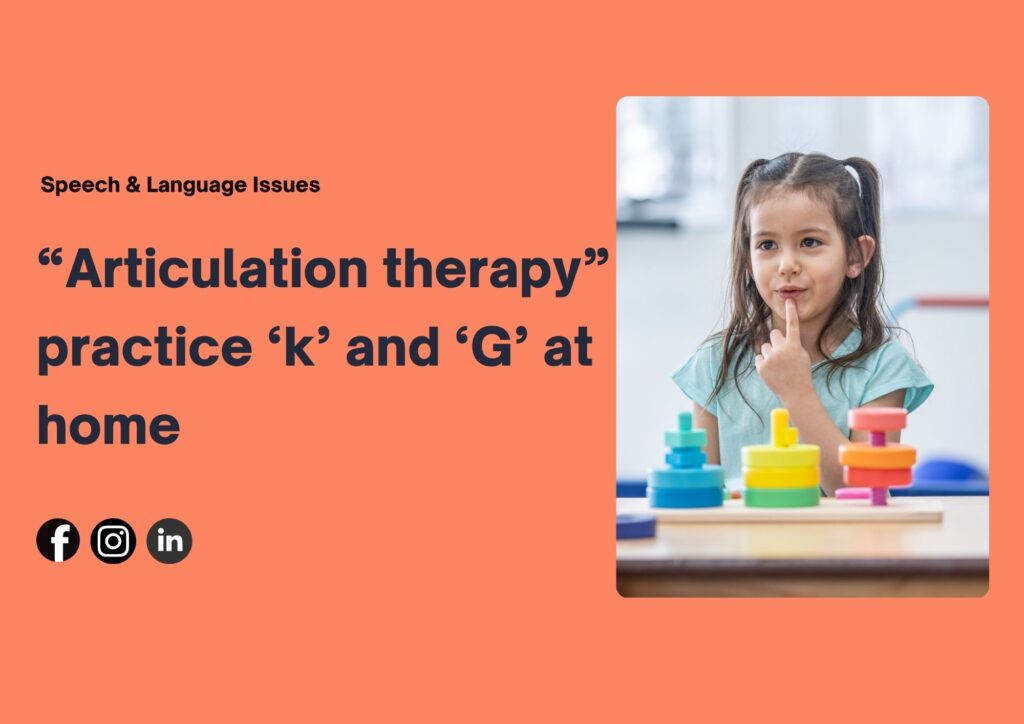
As a speech-language pathologist (SLP), I often see children who have difficulty with articulation therapy focusing on the /k/ and /g/ sounds. These sounds can be tricky because they require precise tongue placement at the back of the mouth. Many parents ask me, “How can I help my child practice these sounds at home?”
In this blog, I will guide you through:
- What happens inside the mouth during articulation therapy for /k/ and /g/
- Why children find it difficult to say /k/ and /g/ sounds
- Fun and effective ways to practice articulation therapy for these sounds at home
What Happens Inside the Mouth During Articulation Therapy for /k/ and /g/ Sounds?
The sounds /k/ (as in “cat”) and /g/ (as in “goat”) are called velar stop sounds. They are made by the tongue touching the soft palate at the back of the mouth. Here’s how your child’s mouth should work during articulation therapy for these sounds:
- Tongue Position: The back of the tongue rises to contact the soft palate (the soft part at the roof of the mouth).
- Airflow: A sudden burst of air is released when the tongue quickly moves away.
- Voicing:
- /k/ is voiceless, meaning no vocal cord vibration (like a soft whisper “kuh”).
- /g/ is voiced, meaning the vocal cords vibrate (“guh”).
Why Do Children Struggle with /k/ and /g/ Sounds During Articulation Therapy?
It is very common for children to replace these sounds with easier ones. For example, they might say “tat” instead of “cat” or “doat” instead of “goat.” This substitution is called fronting—where back sounds (/k/, /g/) are replaced with front sounds (/t/, /d/).
This happens because:
- Tongue is Too Forward: Instead of lifting the back, the child uses the front of the tongue.
- Lack of Awareness: Children often don’t know where their tongue should be placed.
- Weak Tongue Muscles: It can be hard for young children to control the back of the tongue.
Fronting is typical in toddlers but should improve by 3.5 to 4 years. If not, focused articulation therapy is important.
6 Fun and Effective Articulation Therapy Activities to Practice /k/ and /g/ Sounds at Home
Practicing articulation therapy for these sounds can be fun and simple. Here are six activities you can do with your child:
1. Make Your Child Aware of the Back of the Mouth
Stand in front of a mirror with your child. Have them open wide and say “ahh.” Use a flashlight to show the back of the tongue and explain that the tongue needs to lift there during articulation therapy. You can gently press a popsicle stick on the back of the tongue to encourage lifting.
2. Use the Cough Trick
Ask your child to cough — this action uses the same tongue movement needed to produce the /k/ sound. Right after coughing, have them try saying “kuh-kuh.”
3. Practice Dry Gargling for the /g/ Sound
Have your child gargle without water. This simulates the tongue’s movement for producing the voiced /g/ sound. Practice words like “guh-guh” and “go-go.”
4. Practice Sounds While Lying Down
Ask your child to lie on their back and say “kuh-kuh,” “guh-guh,” and “go-go.” Gravity helps the tongue fall back, making these sounds easier during articulation therapy.
5. Block the Tongue Tip
Gently tap the tip of your child’s tongue with a clean finger or spoon while encouraging them to say /k/ and /g/. Remind them to keep the tongue tip down and push the back of the tongue up.
6. Turn Articulation Therapy into a Game
Play a “K Sound Hunt” by finding objects at home that start with the /k/ sound (e.g., cup, cat, car). Games make articulation therapy engaging and enjoyable.
Step-by-Step Progression for Articulation Therapy Practice
When working on articulation therapy for /k/ and /g/, start with simple sounds and gradually move to words, phrases, and sentences.
| Level | Examples |
|---|---|
| Just sounds | kuh, guh |
| Words | cat, car, cup, goat, game |
| Phrases | “Cut cake”, “Go up” |
| Sentences | “The goat is in the car.” |
Make sure your child masters each level before moving to the next.
When to Seek Professional Articulation Therapy for /k/ and /g/ Sounds
If your child is over 4 years old and still frequently substitutes /k/ and /g/ sounds, it’s important to seek help from a certified speech-language pathologist. A professional can provide:
- Structured, personalized articulation therapy exercises
- Specialized cues and strategies
- Regular feedback to track progress
Early professional intervention leads to the best outcomes.
Final Thoughts on Articulation Therapy for /k/ and /g/ Sounds
Helping your child master the /k/ and /g/ sounds through articulation therapy at home is possible with patience, practice, and the right approach. Keep sessions fun, celebrate small wins, and maintain consistency. For more speech therapy tips and resources, visit NeuronurtureKids.com
Ready to Book an Therapy Session? If your child needs additional support with /k/ and /g/ sounds, our certified speech-language pathologists are here to help. Book a Therapy Session Now.